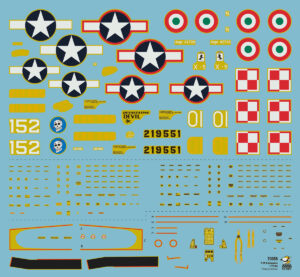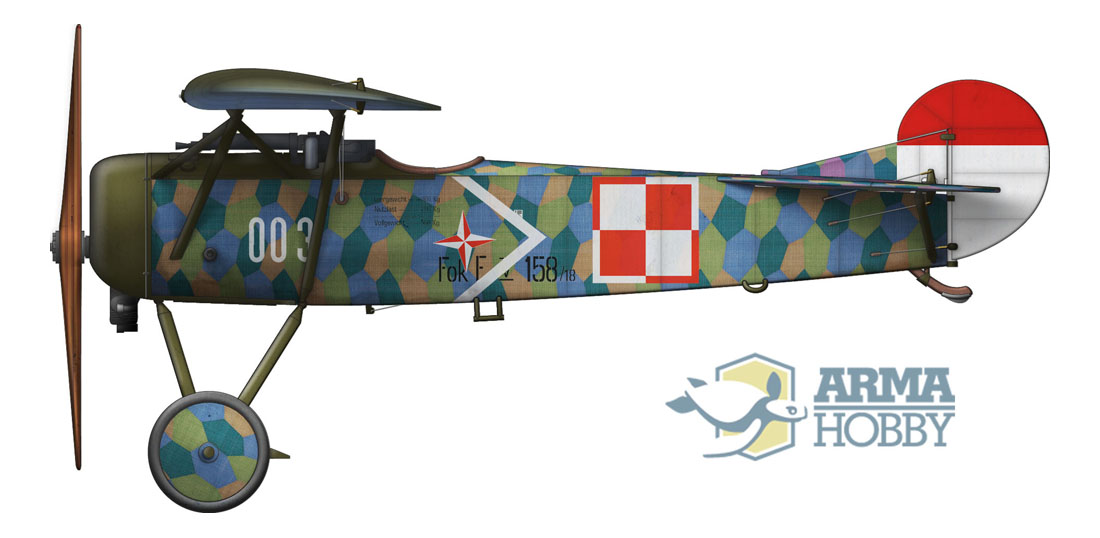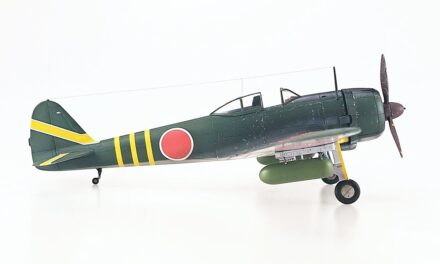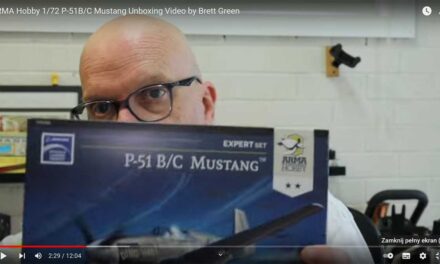P-39 Airacobra’s years of service with the air forces of the United States, Great Britain, Australia and the Soviet Union (and, in the final phase of the war, with those of the French and Italy) led to the adoption of a wide range of camouflage patterns for subsequent versions of the P-39. From among all these various “uniforms”, the most unusual were those worn by the aircraft of 46th Fighter Squadron (FG), 15th Fighter Group (FG), 7th Air Force (AF), which were known as the Makin Island Aircobras.
Despite extensive research and the passage of almost eighty years, the colour schemes of these aeroplanes still raise controversy, stirring the blood of historians and enthusiasts of Second World War aviation and leading to very animated discussions (to use a polite turn of phrase). However, before I attempt to briefly present my views on the issue of specific colours, it is worth mentioning a few words about the history of 46th Fighter Squadron and answering a very fundamental question – where on earth is Makin Island?
Air Cobra from the Bell’s Stable
From the very beginning, the concept of the Bell Model 4 fighter, which later came to be known as the P-39 Aircobra, raised great hopes but also considerable controversy and even serious reservations. The structural design, largely subordinated to the powerful 37 mm cannon, aroused concerns among potential recipients. It was considered that the aeroplane would be too complicated, and therefore difficult to operate. To put it in a nutshell: they anticipated a very fast fighter with immense fire power, but at the same time fickle and requiring constant, meticulous maintenance and sound airfields and landing strips. As regards performance … well, this was an overoptimistic miscalculation, however concerns as to the excessive delicacy of the structure in specific field and climate conditions turned out to be completely unjustified. The Cobras acquitted themselves splendidly, operating with ease in the snows of Alaska, the sands of North Africa, the steppes of the Soviet Union, and the jungles of New Guinea and the Solomon Islands.
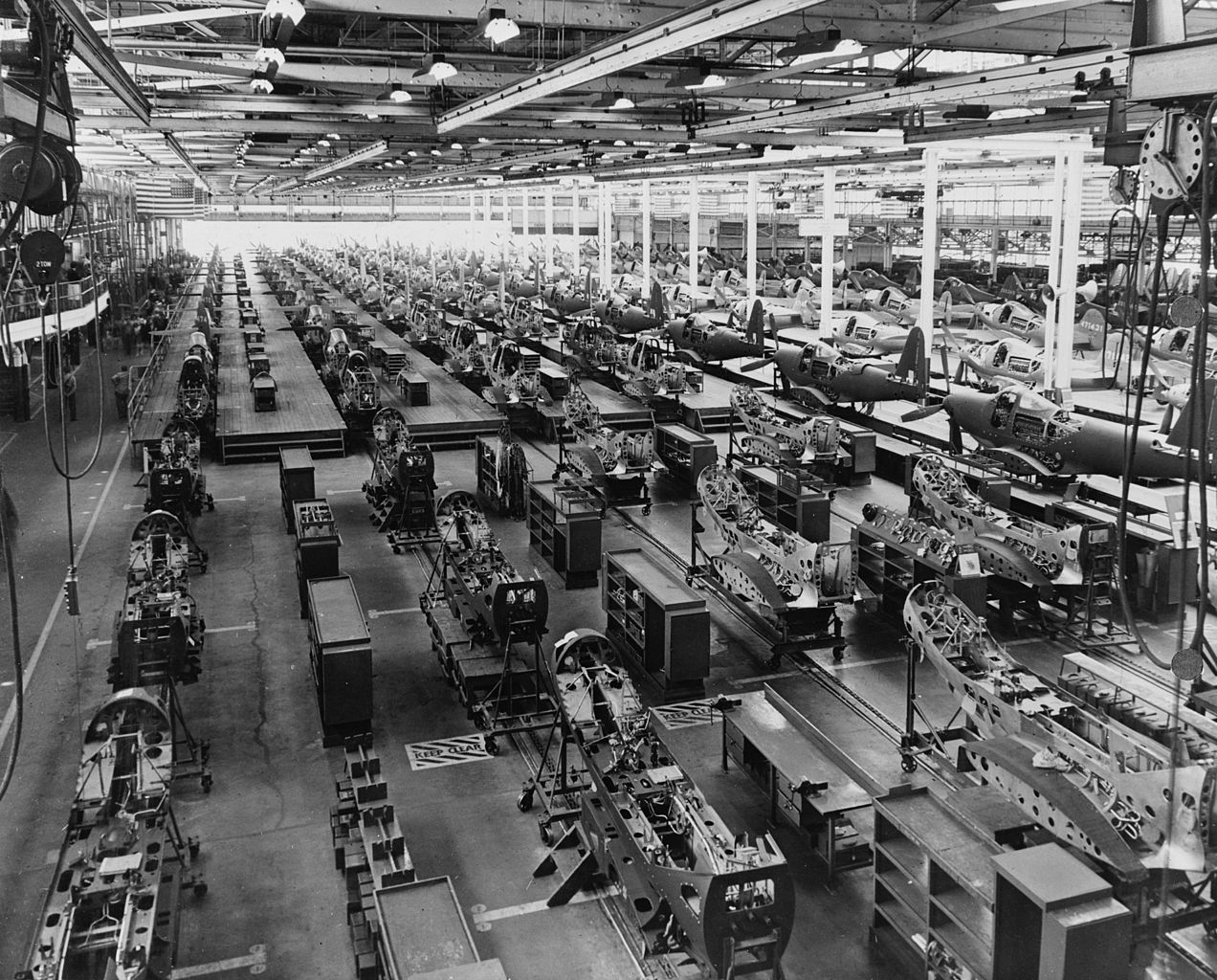
P-39 Airacobra and P-63 Kingcobra production line at the Bell Aircraft Corporation. Photo: Library of Congress
In fact, the only serious drawback of the P-39 was the lack of a turbo-supercharger (which had initially been planned to be installed), which tangibly reduced the aircraft’s combat capabilities at higher altitudes. However, in clashes fought at heights of up to 3,000–4,000 metres, the Aircobras turned out to be fast, manoeuvrable and resistant to damage. Furthermore, thanks to their powerful armament, they proved useful in ground support and assault operations.
The Forty-Sixth
The unit was established by an order dated 22 November 1940, while its actual formation commenced on 1 December. In accordance with the USAAC’s (United States Army Air Corps’) nomenclature of the time, it was named 46th Pursuit Squadron (PS), and, together with 45th and 47th Pursuit Squadrons, formed 15th Pursuit Group (PG). The newly created 15th PG was intended to significantly strengthen the aerial component of the defences of Hawaii, which was based at Wheeler Army Field, also known as Wheeler Field. Initially, it was equipped with the well-liked but terribly obsolete Boeing P-26 Peashooters; these were quickly replaced with the modern Curtiss P-36 Hawks and P-40B Tomahawks, with which it entered the war.
It is not difficult to guess that this “entry into the war” was completely different from what the staff officers and pilots of 15th PG had imagined. Already in the first minutes of the Japanese attack on Pearl Harbor, Wheeler Field was hit by a massive wave of aircraft. To make matters worse, the long-standing tensions in US-Japanese relations had led to the introduction of certain “countermeasures”. Namely, the fighters of 45th PS and 46th PS were deployed directly on the airfield apron and stripped of fuel and ammunition so as to reduce the risk of sabotage. The aircraft of both squadrons, deprived of any means of defence and unable to quickly commence combat, were massacred at their home base.

The Wheeler Field burning after the air raid on 7th December 1941. Photo made by Japanese aircrew
Losses totalled 70–75% of the initial complement, although fortunately casualties among ground personnel and air crews were not as severe. This fate was avoided (to an extent) only by 47th PS, whose fighters had been partially deployed earlier at several other, less exposed points of the island (Bellows, Haleiwa and Mokuleia Field). Lieutenant George Welch and Lieutenant Kenneth Taylor even managed to join the fray (on P-40Bs from Haleiwa), shooting down six Val dive-bombers.
The squadrons of 15th PG remained with the Hawaiian defence forces until the spring of 1943, while on 15 May 1942 they were renamed as 45th, 46th and 47th Fighter Squadrons of 15th Fighter Group, United States Army Air Forces (USAAF). Due to the negligible activity of Japanese military aviation in the region, the very intensive fighter patrols over Hawaii were used mainly for operational training and improving piloting skills. 45th and 47th FS were gradually re-equipped with the newest P-40E and P-40N Warhawks, while 46th FS began to operate Bell P-39D and Q Aircobras. In the spring of 1943, following the successful completion of the Guadalcanal campaign, it was decided to transfer the squadrons of 15th FG to the central Pacific theatre.
Where the Hell Is Makin?
This is an intriguing question, not least because, with the exception of the period December 1941 – February 1944, it has never really aroused any interest. Makin is a small island which constitutes the northernmost tip of the Gilbert Islands archipelago.
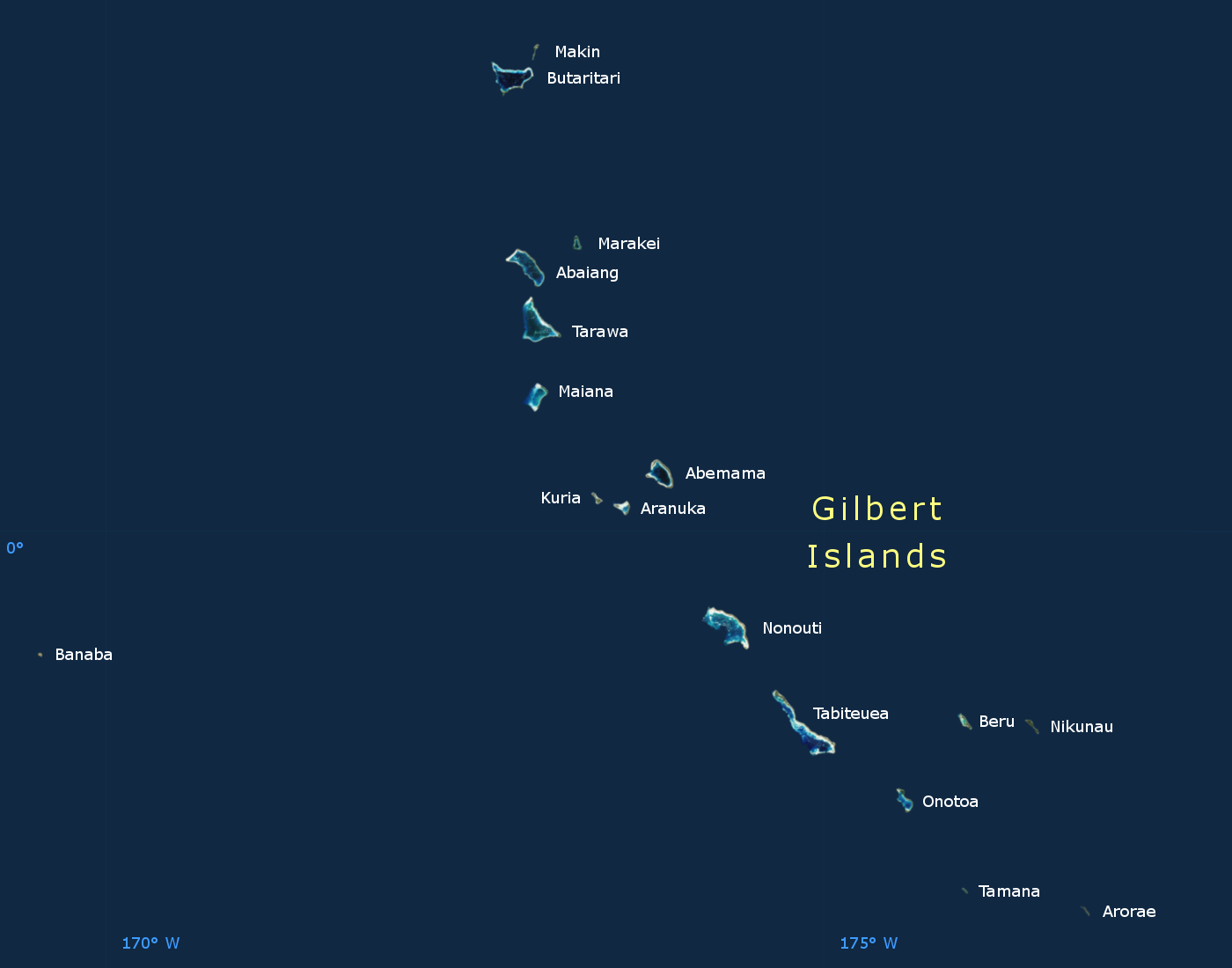
The archipelago itself, stretching from north to south over approximately 300 nautical miles, consists of no more than sixteen islets and atolls of negligible economic importance. Halfway along its length, it is cut across by the equator, while its central point is the largest and most important atoll – Tarawa. Simply put, the Gilbert Islands lie exactly in the middle of nowhere (presently, they are part of the Republic of Kiribati in Micronesia). Towards the end of the 19th century, the archipelago became a British protectorate (in 1916, its status changed to that of a colony of Great Britain), and did not stir any emotions whatsoever – not even in the Crown. The British administration was vestigial at best. The situation changed radically only with the outbreak of the Second World War in the Far East. Why? Well, if we draw a line connecting Guadalcanal with Hawaii, it will pass right through the Gilbert Islands, roughly 1/3 distant from the Solomon Islands. The Japanese, who were targeting New Guinea, the Solomon Islands and Australia itself, viewed the Gilbert Islands as a north-eastern flank that would have to be secured in order to ensure protection against possible operations launched from Hawaii. The Gilbert Islands also constitute the southern part of an undersea mountain range that forms the Marshall Islands archipelago to the north (were the Japanese later established a strong naval base on Kwajalein Atoll). This explains why already on 10 December 1941 the Gilbert Islands, or, to put it more precisely, Tarawa and Butaritari – the only atolls having strategic importance – were seized by the elite Imperial Japanese Marines practically without a fight.
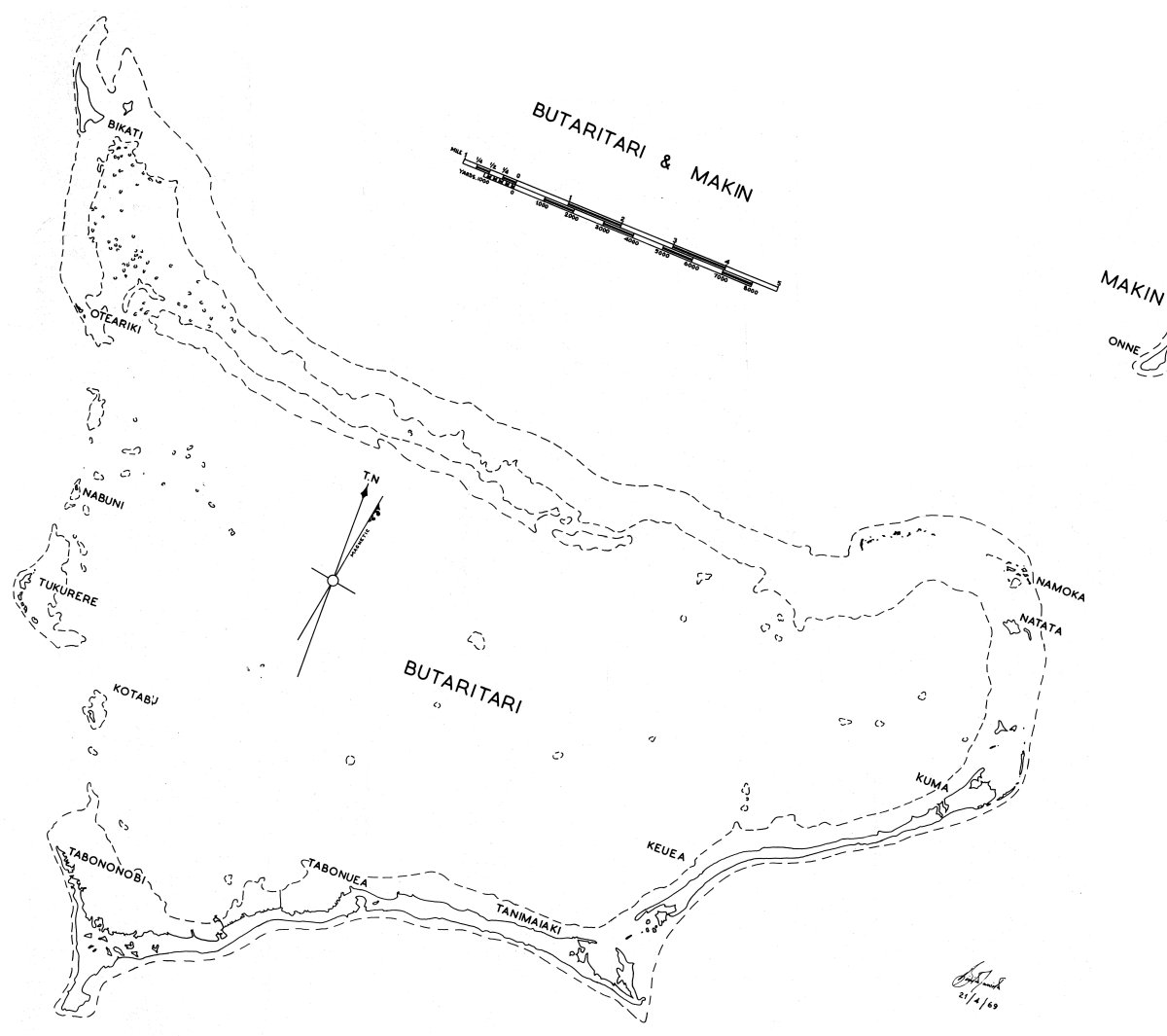
Here, we come to another interesting fact. When mentioning the units stationed on Makin, we are referring de facto to Butaritari Atoll. The aforementioned tiny islet of Makin lies two miles northeast of Butaritari and is completely useless from a military point of view. The Americans, however, named the two fragments of land Makin (Butaritari) and North Makin, or Small Makin (the actual island of Makin). These names have survived to the present day. Thus, when later on in the story I mention “Makin”, I am actually writing about Butaritari Atoll. In any event, developments in the South Pacific caused the Japanese to turn Makin into a veritable “watchtower”. The atoll’s lagoon was to become an anchorage for large reconnaissance flying boats and a handful of local defence float plane fighters. The Japanese garrison of Makin comprised approximately 300 marines and 100 aerial personnel. In addition, 400 Korean forced labourers were sent in to build an elementary system of fortifications. Due to the specific geological structure of the atoll, however, these “fortifications” turned out to be rather weak. Makin’s aerial component was made up mainly of A6M2-N and F1M2 fighters from 802nd and 952nd Kokutai (operating in rotation) and, from time to time, of H6K and H8K flying boats, which normally carried out reconnaissance missions in an eastward direction.
Operation Galvanic
Galvanic was the code name devised for the US Marines’ and Navy’s initial strike against Japanese-controlled islands and atolls in the central Pacific. The American high command was not sure whether actions of this type were actually feasible, and the simultaneous attack on the atolls of Tarawa and Butaritari/Makin was to be a “dress rehearsal” for subsequent landings on key locations, such as the Marshall Islands or the Marianas. And indeed, Operation Galvanic brought to light a host of organizational shortcomings.
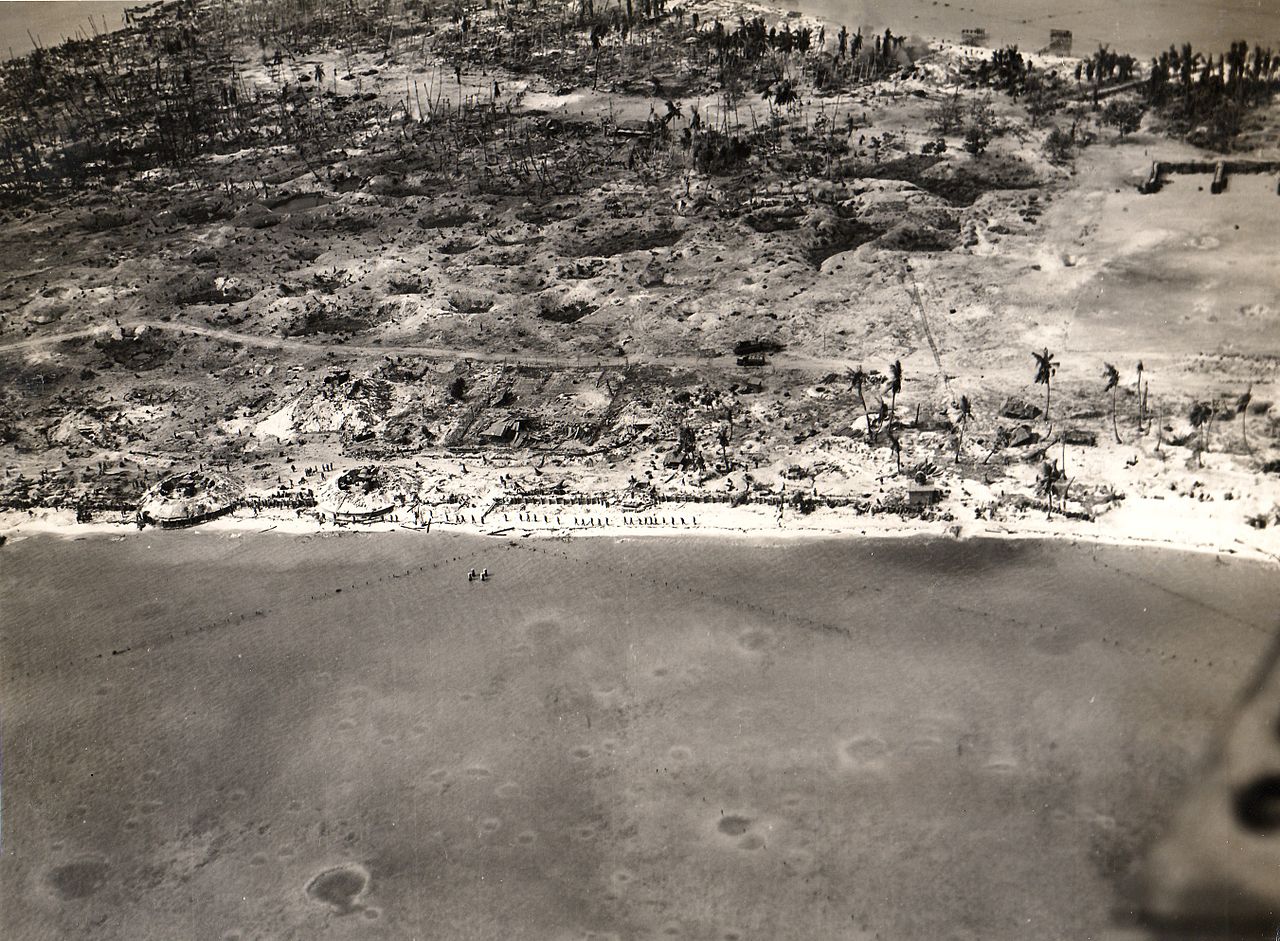
Tarawa, 24 November 1943. Photo: US Navy/public domain
Admittedly, the four-day battle for Tarawa resulted in victory and the complete destruction of the Japanese garrison (3,600 soldiers), but it cost the Americans over 1,000 killed and 2,300 wounded. These data were hidden from the public for a considerable time, for fear of mass protests in the USA. So how did the landing on Makin proceed?
On 13 November 1943, the atoll was raided by B-24 Liberator heavy bombers. In the following days, the offensive was joined by aircraft from the carriers USS Liscome Bay, USS Coral Sea and USS Corregidor, supported by the artillery of four battleships, five heavy cruisers and sixteen destroyers. The Marine Corps commenced the landing operation seven days later, on 20 November. Unfortunately, their effort was a series of terrible tactical blunders, marred by problems with coordination, equipment failures, collisions of landing barges with the surrounding reefs – and numerous other issues. Were it not for the fact that the majority of the defenders had been killed by the air raids and shelling from the sea (which had been going on for a week), the operation would have probably ended in disaster. Nevertheless, it still took three whole days to neutralize the remnants of the Japanese forces. Out of just under 400 defenders, only one was taken prisoner (who due to his wounds was able neither to fight nor commit suicide). Nearly 300 Korean forced labourers were also killed. American losses amounted to sixty-six dead and 155 wounded (the majority were most probably hit by friendly fire), which was considered … acceptable. These, however, were only the losses of the landing units. During the shelling of the atoll, one of the main artillery towers of the old battleship USS Mississippi exploded. Forty-three sailors were killed and the vessel had to be withdrawn from action. Miraculously avoiding a torpedo salvo fired by a Japanese submarine, it somehow dragged itself to Pearl Harbor. However, the escort carrier USS Liscome Bay had less luck. Hit by an accurately launched torpedo, it sank with the loss of 687 men. In other words: at the cost of 800 killed, more than 200 wounded, and a valuable ship, the Americans had captured a tiny island defended by less than 400 Japanese soldiers, three light tanks and four 37 mm field guns. On it, the tireless engineers of the Navy’s Seabees soon built a small airfield called Starmann Field – the future home of the P-39Qs from 46th FS and the P-40Ns of 45th FS.
The Aircobras of the Central Pacific
The order to transfer 46th FS to the new operational area was issued in the early spring of 1943. The landing on the Gilbert Islands was still half a year away, but it was decided that the unit should gain experience in conducting operations in such a unique geographical area. On 27 March, the first Cobras of 46th FS touched down on Canton Island, one of the few small atolls that make up the Phoenix Islands mini-archipelago, which is located more than 1,000 nautical miles east of the Gilbert Islands. In truth, we should say that Canton Atoll was the only patch of “land” in this area that could accommodate a small runway. Today, it is home to a coral reef and fish refuge, as well as a few species of seabirds, and is covered with sparse vegetation that has proved extremely difficult to maintain; in 1943, however, its basic “soil” comprised coral reef and clam shell dust. Against this pale white-pink background, the standard paint scheme (OD/NG) of the Aircobras of 46th FS made them look like flies on a lampshade. And it was this environment that gave rise to the unique camouflage that we have all come to know. A similar problem was encountered (in nearly identical conditions) by the P-40Ns of 45th FS, which had been transferred to Baker Island.
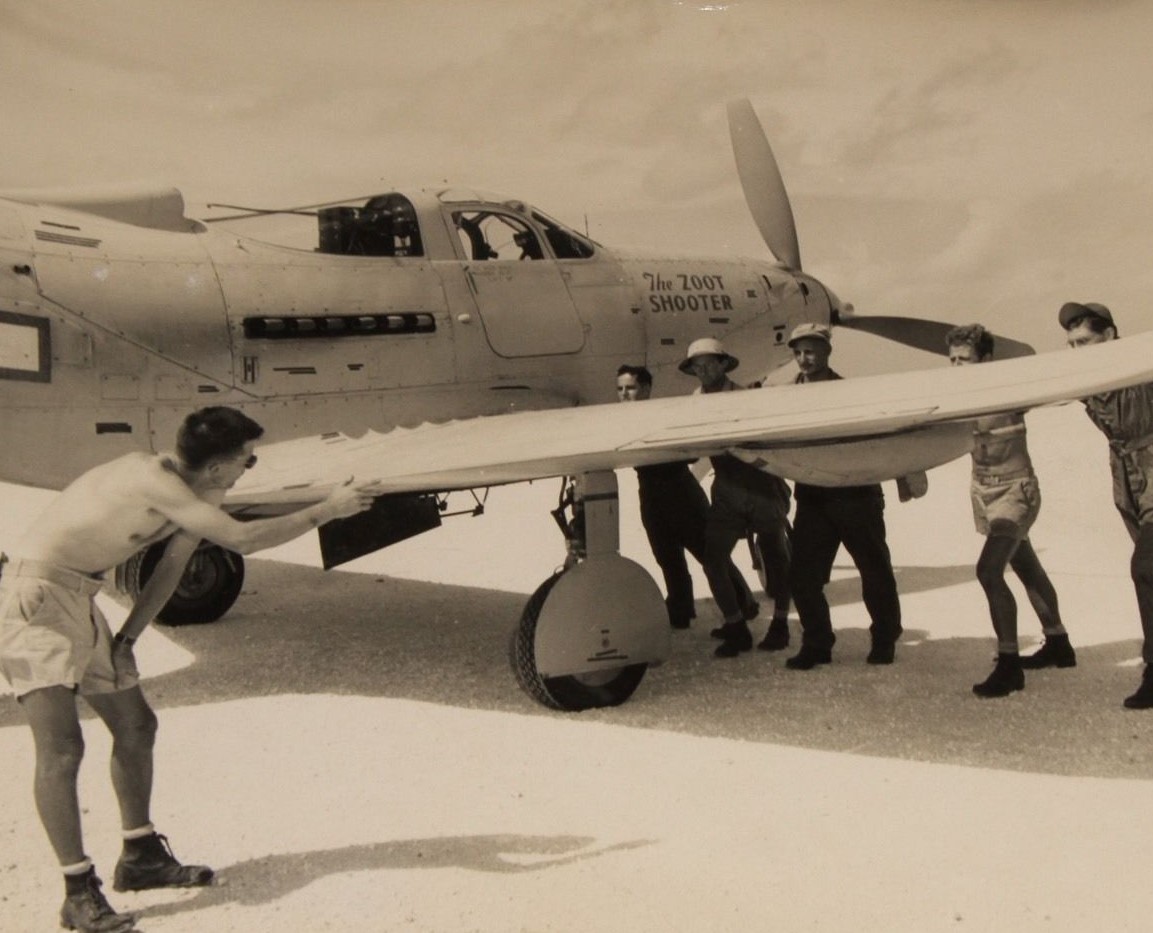
During the next nine months, the pilots of 46th FS carried out long, tedious and on the whole fruitless patrols over the Phoenix Archipelago. The area was significantly distant from the ongoing combat, and even Japanese long-range reconnaissance aircraft did not venture that far. It was assumed that the squadron’s potential opponents would be the huge Kawanishi H6K Mavis and/or H8K Emily flying boats. For this reason, 46th FS, which until then had operated the P-39D, received the completely new P-39Q, and specifically the Q-5 variant (Bell Model 26Q-5). Let us mention here that the main features distinguishing the Q version from the D were stronger armament and reinforced armour, which ensured that the fighter was better prepared for combat against multi-engined opponents. The four 0.3 inch wing-mounted machine guns (two in each wing) were replaced with two pods fitted with 0.5 inch heavy machine guns with 300 rounds per barrel. The aeroplane’s main armament – a single 37 mm cannon firing through the propeller hub – was retained. An additional feature of the Q-5 version was a slight reduction of armour plating in comparison with the original Q variant, which made it possible to increase the volume of fuel carried by the aircraft from 3,250 litres (86 gallons) to 4,160 litres (110 gallons). Taking into account the vastness of the ocean surrounding Canton Island, this was an invaluable modification.
Irrespective of the advantages offered by the new fighters, the pilots of 46th FS were mercilessly bored and greeted the news of being transferred closer to the front line with great enthusiasm. In mid-December 1943 (three weeks after the capture of Makin), work on the construction of the runway was completed, and the first Aircobras landed on the 18th of the month.
Combat flights from Makin
One of the first encounters in the vicinity of the atoll took place towards the end of December, just a few days after the arrival of 46th FS. Its participants were an H6K Mavis flying boat and the P-39Q “Devastating Devil” (serial number 42-19551). There exist a number of pictures portraying the “Devil” flying over the Mavis, which is shown falling in flames. But the truth was somewhat different. The pilot of the Aircobra, Lieutenant Jack Garnett, did not report shooting down – or even damaging – the enemy aircraft. Probably, therefore, no exchange of fire occurred. In the following days, there were several similar interceptions of Mavises and G4M Betties, but the Japanese aeroplanes kept a reasonably safe distance, while some of their missions took place at night (or, to put it more precisely, in the very early morning or late evening). The absolutely cloudless sky over the archipelago allowed the enemy to carry out their reconnaissance missions without taking excessive risks. Nevertheless, in early January 1944, Captain Felix O. Scott, who was piloting the Aircobra “Texas Ed II” (serial number 42-19547), caught up with a lone G4M Betty and sent it crashing into the sea. One of the most interesting missions of 46th FS was carried out on an Aircobra that had been acquired … by accident. A P-39Q-5 of 72nd FS made a forced landing on Makin due to technical problems. The landing ended in a crash, although the pilot emerged from the accident without any major injuries and soon returned to his unit. The fighter was supposed to have been written off, but the mechanics of 46th FS, who had a large assortment of parts taken from some older aircraft, decided to bring it back to life. Their efforts at self-assembly resulted in the creation of a bona fide Aircobra, which (in light of the circumstances of its reconstruction) was given the name “Spare Parts”. The aeroplane was assigned to night patrols over Makin and was therefore painted entirely with glossy black paint, which was normally applied in the squadron to propeller spinners. Interestingly, the procedure resulted in the complete obliteration of the fighter’s serial number. Since no one had bothered to write it down, the witty technicians replaced it with a question mark (?).

Unfortunately, the Japanese practically abandoned their sorties over the atoll – but this did give rise to an unusual mission. Piloted by Lieutenant Ben Warren, “Spare Parts” set off for a night sweep over Mille (Mili) Atoll in the Marshall Islands archipelago. Since he was expected to maintain an eminently safe distance from the Japanese base, the 0.5 inch Browning pods were removed, and the fighter’s only armament was the 37 mm fuselage-mounted cannon with a standard supply of ammunition. As rumour has it, on the night of 15/16 January 1944, Lieutenant Warren shot down two Betties near Mille.
Having operated from Makin for just under two months, 46th FS was recalled to Hawaii. Its place was taken by 45th FS, but it too returned to Oahu in mid-April. In the absence of the enemy, further patrols over the Gilbert Islands archipelago were no longer required. Both units were assigned other objectives and provided with completely new aircraft.
Camouflage and markings
Let us now move on to a topic issue that will really excite modellers – the colour schemes of the Aircobras of 46th FS while it was stationed at Canton and Makin. Heated discussions on the issue commenced around the mid-1970s. In the main, they originated from a statement made by one of the squadron’s technical officers, Lieutenant John W. Lambert: “We painted them in a coral sand colour on the topside and a light blue on the underside. Looking up, you could barely see them against the sky”.
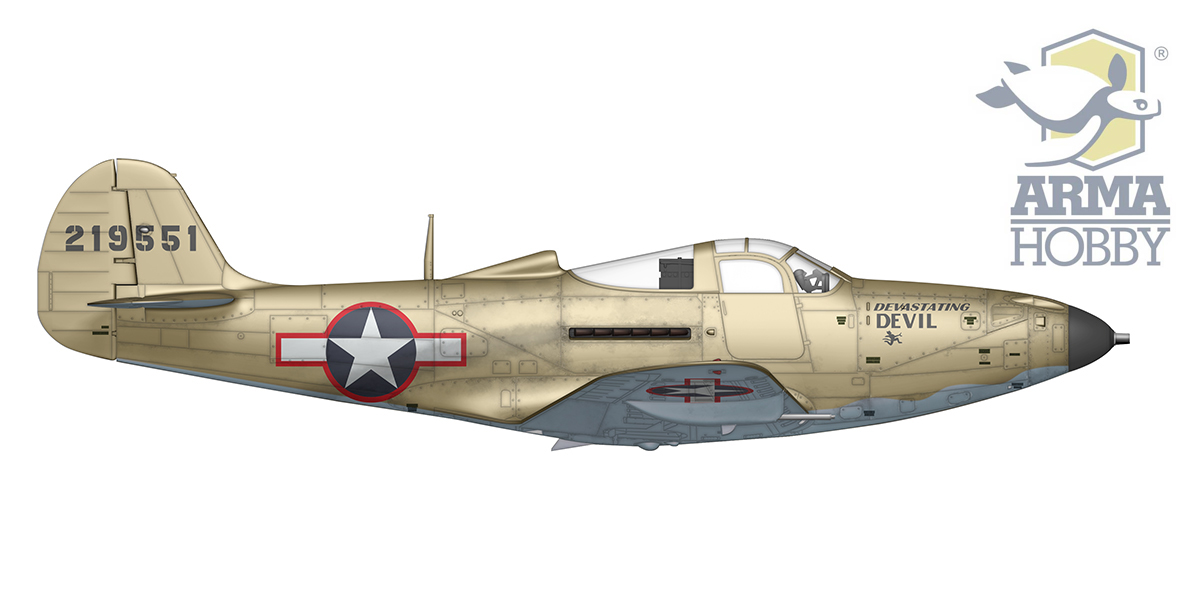
His very general description gave rise to a number of theories about the use of beige, light grey, salmon, and even white or pink. This was all speculation, however, although (unfortunately) supported by a broad range of colour plates and drawings created ad hoc for the purposes of successive publications. And so at some point it “became established” that the P-39s operating from Makin had a coral pink camouflage. Luckily, professional researchers and historians also made a contribution, gathering a large number of documents and accounts, and conducting a thorough analysis of, among others, photographic materials and the logistical channels used by the Americans to provide operational supplies. I have presented the results of their research, which are presently considered to be highly accurate and appear to be most compatible with the realities of the era, in the following subsections.
Camouflage
The first puzzle, albeit one that was quickly solved, concerned the light blue colour of the underside. It turned out that the paint was prepared as a mix of Insignia White No. 46 and Insignia Blue No. 47 in a proportion of more or less 70:30. Incidentally, it also transpired that while the underside (along with the 0.5 inch heavy machine gun pods) was painted in this colour, the additional fuel tanks were not. These received the standard Neutral Grey, while in some instances they were reportedly left in their natural aluminium finish.
The upper and side surfaces of the monoplanes were covered with Sand paint, although there is no precise indication of the colour tone. The problem here is that at the time the USAAF used two slightly different shades in parallel: the standard Sand No. 49, and the slightly lighter Sand No. 26 (sometimes also called Faded Sand or Flat Sand). Where did this difference stem from? The USAAC had entered the war equipped with the colour pattern book published in Army Air Force Bulletin No. 41 of 16 September 1940. It contained only eight colours: OD, MG, NG, Insignia Red/Blue/White and Identification Yellow. In May 1942, ten more were added, however clearly marked as temporary (they were developed mainly for the African Theatre of Operations, although they were sometimes also used in other parts of the world). Sand – and specifically Sand No. 26 – was amongst this group. Whereas Sand No. 49 was introduced in August 1942, although not as a “temporary” hue, but as a permanent, ninth, supplementation of the eight original colours enumerated in Bulletin No. 41. We have been unable to establish with absolute certainty whether the Aircobras of Canton and Makin were given the Sand 26 or the Sand 49 camouflage.
In the preceding century, manufacturers of modelling paints referred the colours and shades of their products to the Federal Standard (FS) 595a pattern book. It is not surprising then that modellers tend to base themselves on the FS numeration. The closest equivalent of Sand 49 is FS 30279, while that of Sand 26 is FS 30475 (more or less). Keep in mind, however, that this information is very approximate. The FS 595 (FED-STD-595) pattern book was introduced in 1956, while its modified form, FS 595a (commonly used by modellers and chemical manufacturers), has been in force since the end of 1960.
When building a faithful miniature of a P-39Q from Canton and Makin, it is also worth taking into account the specificity of the region’s climate. On the island of Canton, completely devoid of vegetation, the aircraft of 46th FS were exposed to constant sunlight and very high temperatures (over a period of 9 months), and also to seawater spray. Canton is a tiny atoll, with an average height above ocean level of only three or so metres. Admittedly, the paint was applied by spraying, but under field conditions. The durability of the coating left much to be desired.

The well-known photograph of “Devastating Devil” does not show just how much the camouflage could fade, however it does present discolourations of the frontal part of the fuselage and the wing leading edges. During normal operations, the air stream (and probably also the coral dust) would have removed part of the coating, making the original Olive Drab clearly visible. As likely as not, areas over which the pilots and ground crews walked experienced a similar deterioration.
To conclude the topic of the basic camouflage colours of the Aircobras of 46th FS, we can state that they wore their characteristic blue and sand uniforms throughout the entire period of service on Canton Island, and arrived at Makin in the same livery. However, there was plenty of vegetation around the new base – including thick palm groves. There, the aircraft’s “coral” colour scheme had no justification. In a short space of time, the fighters were restored to their original Olive Drab camouflage, although the undersides remained blue.
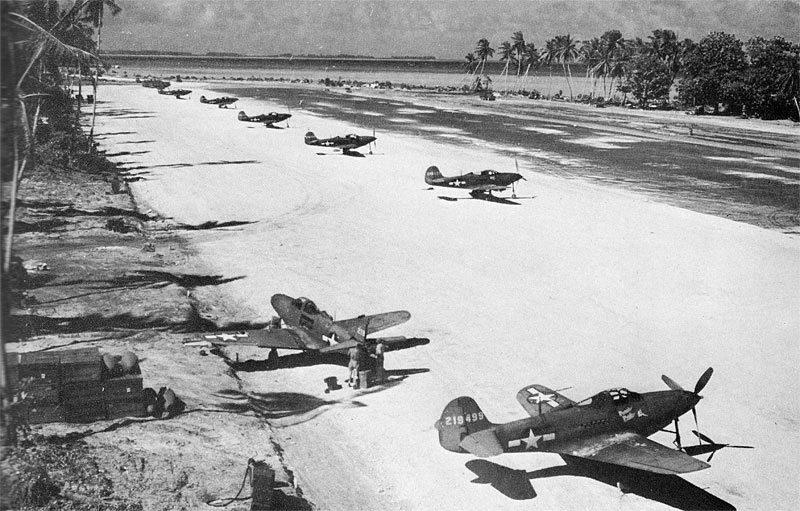
The attached photograph of a P-39Q from 46th FS was taken from the archives of the USAAF, and is dated to about a week after the squadron’s arrival at Makin (probably 25–27 December 1943). As we can easily see, all the Cobras are already olive-coloured.
The national markings
During the period when 46th FS operated the sturdy Aircobra, the insignia denoting state affiliation were changed a number of times. The first P-39Qs carried Type 3 markings (Insignia Spec. No. 24102-K), that is, white stars in a navy blue circle. Subsequent versions had AN-I-9a insignia with the addition of white stripes and red edging (late June 1943 – mid-September 1943). The final models had AN-I-9b markings, which were identical to the previous with the sole exception of the trim, which was navy blue. However, for reasons that are probably purely aesthetic in nature, many plates and illustrations present the fighters of 46th FS with a red edging. This form of the marking survived for quite a long time in the African and European (Italian) Theatres of Operations. But in the Pacific, it was quickly changed (for obvious reasons), even before mid-September 1943, when the AN-I-9b version came into force. Thus, some of the P-39Qs stationed on Canton Island may have briefly carried a red trim, however this was swiftly painted over with Insignia Blue. Whereas the early insignia, without the “arms”, remained practically unmodified until the aircraft were repainted on Makin. This is well illustrated by the photographs of, for example, P-39Q “Impatient Virgin” or “Pat-Riot II”.
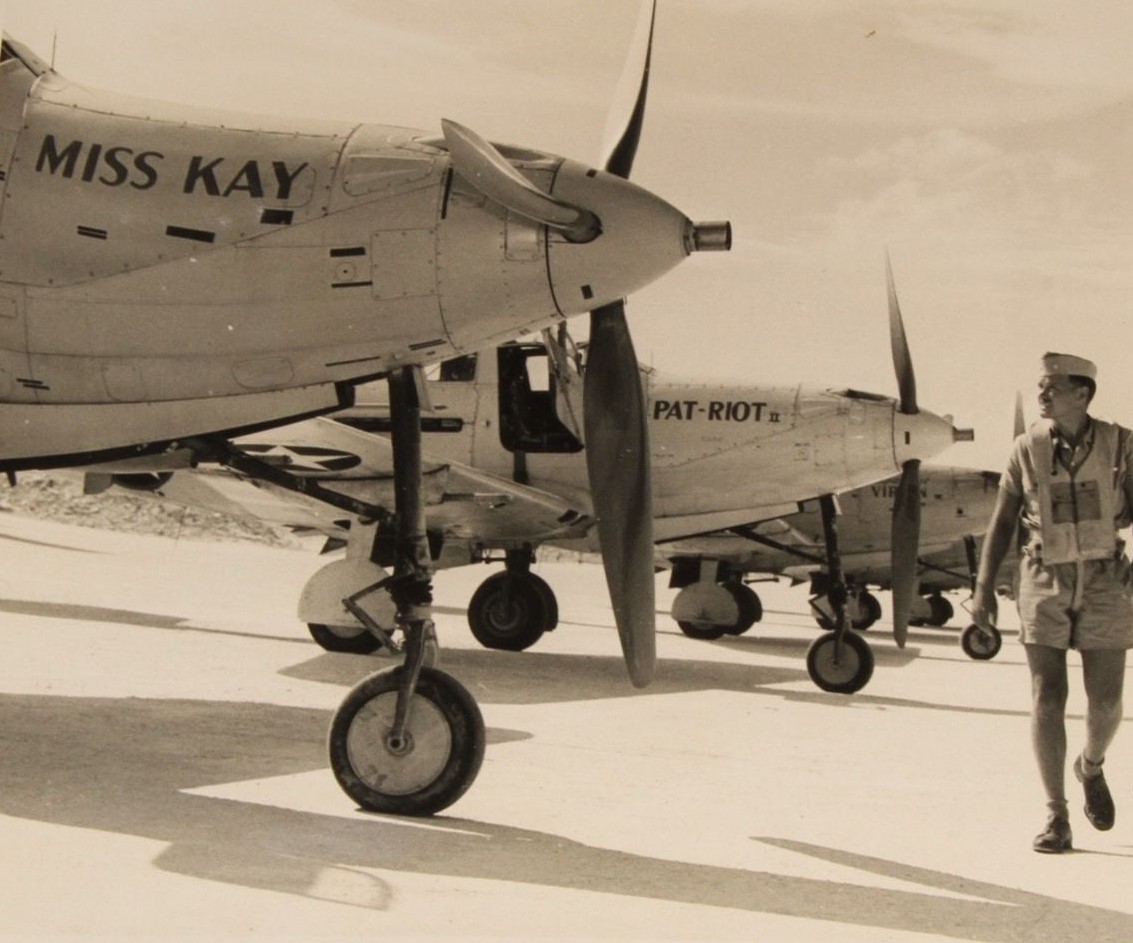
Numerous colour plates, too, suggest that red was used to paint the individual names of the unit’s fighters. Occasionally, these are full names, while sometimes only their fragments (such as, for example, “Devastating Devil”, where the word Devastating and the silhouette of the devil were supposedly red). Unfortunately, this interpretation is not confirmed by any documents or memoirs. To my knowledge, all individual names were painted entirely in glossy black, both on Sand and OD camouflage. The only known exception was “Spare Parts”, mentioned above. Since the aircraft was completely black, its name was painted in red with a yellow border around all of the letters.
Stenciling and warning lines
The change of camouflage from OD to Sand brought with it a dilemma – what was to be done with the small though useful stencilings? The problem was resolved by covering these areas with masking tape, which resulted in the characteristic OD “stripes” on the Sand background.

In some cases, however, the ground crews went to extra trouble and, after repainting the entire airframe, laboriously recreated the more important technical inscriptions by hand. An example of a fighter which received this treatment was “Pat-Riot II”, as can clearly be seen in the photographs. Warning lines on the wings and around the air inlets were masked or recreated in a similar way (using Insignia Red). However, it is possible that on some of the aeroplanes these lines were completely covered with Sand. All the Cobras of 46th FS had their serial numbers painted over (yellow on OD) and then recreated in black.
Epilogue
Following their return from Makin to Hawaii in the spring of 1944, it was planned that both squadrons would be converted into long-range fighter units. 45th FS commenced training on the P-38 Lightning, and 46th FS on the P-47 Thunderbolt. Initially, they were to take part in the battle for the Philippines; ultimately, however, this did not come about. Shortly before they were due to be transferred to the archipelago, both were ordered to re-equip with the North American P-51D Mustang – the USAAF’s latest wonder. In the first quarter of 1945, the two squadrons arrived at the Marianas, where they waited for the Iwo Jima campaign to end. They soon made themselves at home on the island and became part of the so-called “Tokyo Club”. At first, their missions consisted mainly in escorting B-29 Superfortress formations, which raided the Japanese home islands from bases on Saipan, Guam and Tinian. However, Japan’s waning resistance and the virtual destruction of the Imperial Japanese Army Air Force (IJAAF) and the Imperial Japanese Navy Air Force (IJNAF) in the Battle of Okinawa meant that they received other tasks as well. Increasingly, the Mustangs of 45th and 46th FS were sent to attack enemy naval and air bases, transport hubs, small supply ships, and secondary infrastructural targets. Both squadrons also conducted classic air sweeps over the Kanto Valley area and Tokyo itself. In the summer of 1945, Lieutenant Jack Garnett – the pilot of “Devastating Devil” who had unsuccessfully sortied against an H6K Mavis near Makin – scored his first confirmed (and, as it seems, only) aerial victory over Japan.
English translation: Maciek Zakrzewski
Aeroplanes’ photos via Author
See also:
- Order P-39Q Airacobra 1/72 and 1/48 model kits in the Arma Hobby online store
A lover of strong coffee and dark chocolate, incurable optimist, romantic and dreamer, economist by education, historian and modeller by passion. From time immemorial he has been fascinated with aviation in every variety and form. For many years, he has been paying special attention to all aspects of the activities of the Army and Navy Aviation of the Land of the Rising Sun.
This post is also available in:
 polski
polski




